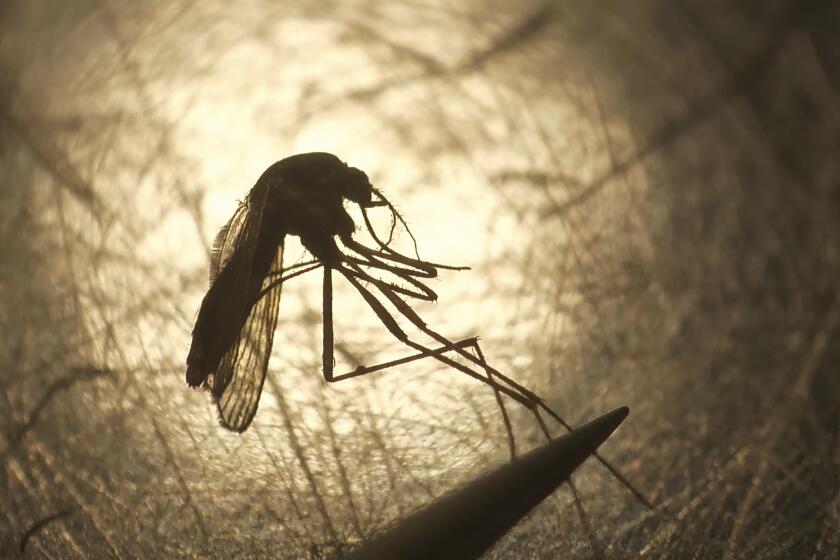Op-Ed: Mosquitoes taking over your California backyard? Here’s how you can fight back

We’re in the midst of severe drought, yet it’s more common than ever to get a mosquito bite in California. People can be heard lamenting that the Golden State is turning into humid Florida.
What we are experiencing is the success of Aedes mosquitoes, which invaded California beginning in the early 2000s and become peskier every year. Aedes may have escaped some of the natural controls — pathogens and predators — that evolved in their home environments.
Scientifically speaking, Aedes is a mosquito genus that includes three species that are present in California but not native to the state. Aedes albopictus, the Asian tiger mosquito, was the first to arrive, introduced in shipments of ornamental bamboo. In 2013, breeding colonies of Aedes aegypti made their way to California after successfully inhabiting the southeastern United States. Scientists have also observed Aedes notoscriptus in the state. All three species have spread diseases such as dengue fever and Zika virus in other countries.
Climate change is furthering the likelihood of Aedes invasions in temperate zones by increasing the number of life cycles the mosquitoes can complete within a year, according to a paper published last year in the scientific journal Nature Communications. That means mosquito-borne diseases are more likely to spread with a warming climate. Across the world, mosquito-borne illnesses kill more than a million people a year.
California’s Mediterranean climate, with its hot, dry summers, should be arid enough to eliminate the standing water that serves as a breeding ground for mosquitoes. But even in a Southern California that is increasingly dry due to climate change, mosquitoes exploit a human-created niche in our local ecosystems: irrigated landscapes. Aedes have a talent for finding and using small bodies of water for reproduction. Even a bottle cap filled with water will do.
If your choice is between using insecticides or being bitten by mosquitoes, what’s the right thing to do?
Of course, mosquitoes can be controlled through the widespread use of chemicals. In the U.S., DDT was commonly used from the 1940s through the 1960s to control agricultural pests and mosquitoes. But DDT is a broad-spectrum insecticide that led to a series of cascading problems, including a decline in bald eagle and peregrine falcon populations, and it was banned in 1972.
In an attempt to control the Mediterranean fruit fly, helicopter flyovers regularly dotted the nighttime sky in the 1990s as neighborhoods were sprayed with the pesticide malathion to kill the medfly. To counter West Nile virus in 2004, officials applied malathion in a more limited and targeted fashion in California.
But tools other than pesticides are available to combat insect pests. Scientists are developing safer, more effective interventions to control insect populations by changing their breeding behavior. For instance, sterile medflies are released to help control reproduction. Similar techniques are in development to deal with ever-expanding mosquito populations.
Homeowners and apartment dwellers already have the ability to help keep mosquito populations in check. For their gardens, they can choose drought-tolerant native plants that require less irrigation, particularly in the summer. Once established, some native plants, such as manzanitas and sages, don’t need to be watered.
Gardeners can also take to heart the Greater Los Angeles County Vector Control District’s educational slogan to remind us to eliminate standing water in our yards: Tip, Toss and Take Action. Tip out any standing water, toss out unneeded containers that collect water and take action by sharing mosquito prevention tips with others.
Southern Californians have also gotten used to semitropical landscaping that requires irrigation, which has helped mosquitoes thrive. When making large-scale landscape decisions, people should avoid water-hungry turf grass and choose native flora since it needs less water and leads to fewer mosquitoes.
It also provides other benefits. Native vegetation supports biodiversity by encouraging native insects that feed birds and other creatures. Nonnative species — such as jacaranda, most palm trees and bougainvillea — don’t do this as well.
In California, oak trees and shrubs like buckwheat and Ceanothus (also known as California lilac) flourish. By planting these and other native species, people can have a positive effect on the environment by creating a cooling habitat that uses less water. An added benefit: It will reduce the need for summertime irrigation that promotes mosquito reproduction.
Sophie Parker is a lead scientist with the Nature Conservancy’s California chapter.
More to Read
A cure for the common opinion
Get thought-provoking perspectives with our weekly newsletter.
You may occasionally receive promotional content from the Los Angeles Times.











